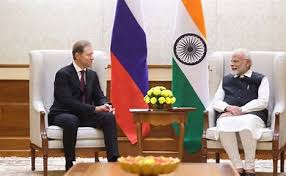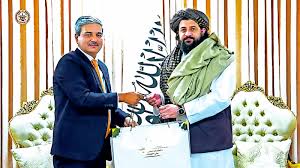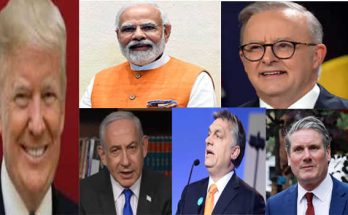 Look East. And follow the Asian Dream. Intertwining economies, interlinking destinies and creating an arc of prosperity across the region, India’s Look East Policy is cruising along on a higher trajectory. After putting India’s South Asia diplomacy in high gear, the new government in Delhi is now looking East as External Affairs Minister Sushma Swaraj heads to Myanmar, the chair of the 10—nation Association of Southeast Asian Nations (ASEAN) and the 18-nation East Asia Summit (EAS). In Myanmar, the minister will participate in India-ASEAN ministerial meeting, ASEAN Regional Forum (ARF) foreign ministers’ meeting and East Asia summit ministerial meeting. Put together, these separate but interlinked meetings reflect various facets of India’s Look East policy and will set the tone and tenor for the visit of Prime Minister Narendra Modi to Myanmar in November for the India-ASEAN summit and EAS.
Look East. And follow the Asian Dream. Intertwining economies, interlinking destinies and creating an arc of prosperity across the region, India’s Look East Policy is cruising along on a higher trajectory. After putting India’s South Asia diplomacy in high gear, the new government in Delhi is now looking East as External Affairs Minister Sushma Swaraj heads to Myanmar, the chair of the 10—nation Association of Southeast Asian Nations (ASEAN) and the 18-nation East Asia Summit (EAS). In Myanmar, the minister will participate in India-ASEAN ministerial meeting, ASEAN Regional Forum (ARF) foreign ministers’ meeting and East Asia summit ministerial meeting. Put together, these separate but interlinked meetings reflect various facets of India’s Look East policy and will set the tone and tenor for the visit of Prime Minister Narendra Modi to Myanmar in November for the India-ASEAN summit and EAS.
Enhanced Look East policy
 The meetings will put the spotlight on India’s blossoming ties with ASEAN and the larger East Asia region, home to the world’s rapidly growing economies. Launched in the early 1990s that coincided with path-breaking economic reforms, India’s Look East policy has now acquired substantive economic and strategic weight. Nearly two years ago, in December 2012, the leaders of India and the ASEAN gathered in the Indian capital to celebrate two defining milestones in their relationship: the 20th anniversary of India’s sectoral dialogue partnership with the ASEAN and the 10th anniversary of their annual summits. India-ASEAN ties have now entered a new high-speed phase, which experts are rightly calling “Enhanced Look East” policy or “Look East Policy: 3.0.”
The meetings will put the spotlight on India’s blossoming ties with ASEAN and the larger East Asia region, home to the world’s rapidly growing economies. Launched in the early 1990s that coincided with path-breaking economic reforms, India’s Look East policy has now acquired substantive economic and strategic weight. Nearly two years ago, in December 2012, the leaders of India and the ASEAN gathered in the Indian capital to celebrate two defining milestones in their relationship: the 20th anniversary of India’s sectoral dialogue partnership with the ASEAN and the 10th anniversary of their annual summits. India-ASEAN ties have now entered a new high-speed phase, which experts are rightly calling “Enhanced Look East” policy or “Look East Policy: 3.0.”
Economic synergy
Economically, the India-ASEAN relations have acquired an unstoppable momentum. The India-ASEAN trade has crossed $80 billion. The signing of a Free Trade Area in goods in 2009 was a game-changer of sorts, and now the two sides are looking to sign the India-ASEAN Free Trade Agreement on Services and Investment. With the institutional framework in place, the two sides are now confident of scaling the India-ASEAN trade to $100 billion by 2015 and double that volume by 2022.
Strategic Depth
 In recent years, India has taken a slew of steps to galvanise relations with this economically vibrant region, which includes the setting up of an Indian mission to the ASEAN in Jakarta, and the decision to set up an ASEAN-India Centre for Trade and Investment. While trade and investment remain the core of the India-ASEAN engagement, the two sides have opened new vistas of cooperation on cross-cutting security issues and imbued bilateral ties with the much-needed strategic depth. The festering tensions in the South China Sea have lent an added urgency to the strategic dimension of the relationship.
In recent years, India has taken a slew of steps to galvanise relations with this economically vibrant region, which includes the setting up of an Indian mission to the ASEAN in Jakarta, and the decision to set up an ASEAN-India Centre for Trade and Investment. While trade and investment remain the core of the India-ASEAN engagement, the two sides have opened new vistas of cooperation on cross-cutting security issues and imbued bilateral ties with the much-needed strategic depth. The festering tensions in the South China Sea have lent an added urgency to the strategic dimension of the relationship.
With the economies of India and the ASEAN growing and their energy needs going up, another area that is bringing the two sides closer is the pursuit of maritime security and enhanced cooperation in combating terrorism and piracy. India has consistently pitched for freedom of navigation, which has received across-the-board endorsement from ASEAN nations and East Asia. On these trans-national issues, India is not only active on the ASEAN track, but has also been a proactive participant in shaping discourse on these issues in the ASEAN Regional Forum and the East Asia summit process. India sees the 27-member ARF as a key regional platform for forging consensus on security issues and evolving an inclusive regional architecture. This year, the ARF is expected to discuss a cluster of regional and global issues, including the rise of radical extremism in Iraq, the Syria crisis, Afghanistan and the North Korea nuclear tests. While the ARF and East Asia summit have their own agenda and raison d’etre, New Delhi sees the ASEAN-India strategic partnership as “an anchor for peace, stability and prosperity in the region as also globally.” India has also underlined the centrality of ASEAN to regional fora such as the East Asia Summit, the ASEAN Regional Forum, the ASEAN Defence Ministers’ Meeting Plus and the Expanded ASEAN Maritime Forum.
Taking a long-range view, India has robustly backed the creation of an ASEAN Community by 2015, the precursor to an unfolding Asian century, the Initiative for ASEAN Integration (IAI) and the Narrowing of the Development Gap. In pursuit of these goals, India has been prompt with buttressing capacity building through the Entrepreneurship Development Centres (EDCs) and Centers for English Language and Training (CELTs) in CLMV (Cambodia, Myanmar, Lao PDR and Vietnam) countries. India has also offered more than 1100 scholarships to ASEAN countries under the Indian Technical and Economic Cooperation (ITEC) programme.
Only Connect
 Connectivity is the reigning mantra as India deepens its diplomatic, economic and cultural ties with its extended neighbourhood. India has vigorously backed fast-tracking a host of connectivity projects that will quicken regional integration and has supported the Master Plan on ASEAN Plus Connectivity (MPAC). New Delhi is also looking forward to conclusion of negotiations for an ASEAN-India Transit Transport Agreement by 2015. The Tamu-Kalewa-Kalemyo sector of the India-Myanmar-Thailand Trilateral Highway is progressing well – the completion of this project in 2016 is poised to create a new dynamic in India’s multi-faceted relations with the region. India has backed the extension of this highway to Laos, Cambodia and Vietnam, its further linkage with ports in ASEAN countries and its integration with models like Special Economic Zones. Enhancing connectivity to Southeast Asia is critical to unlocking the economic energies and enterprise of India’s north-eastern states, which border the region.
Connectivity is the reigning mantra as India deepens its diplomatic, economic and cultural ties with its extended neighbourhood. India has vigorously backed fast-tracking a host of connectivity projects that will quicken regional integration and has supported the Master Plan on ASEAN Plus Connectivity (MPAC). New Delhi is also looking forward to conclusion of negotiations for an ASEAN-India Transit Transport Agreement by 2015. The Tamu-Kalewa-Kalemyo sector of the India-Myanmar-Thailand Trilateral Highway is progressing well – the completion of this project in 2016 is poised to create a new dynamic in India’s multi-faceted relations with the region. India has backed the extension of this highway to Laos, Cambodia and Vietnam, its further linkage with ports in ASEAN countries and its integration with models like Special Economic Zones. Enhancing connectivity to Southeast Asia is critical to unlocking the economic energies and enterprise of India’s north-eastern states, which border the region.
Cultural affinity
 Connectivity is not just geographical and physical; what animates India’s engagement with the region are cultural and spiritual connections, grounded in history and a shared civilizational space. It is from India Buddhism flowed to Southeast Asian countries, as Buddhists from all over the region flock for pilgrimage to revered shrines Mahabodhi Temple in Bodh Gaya, the sacred place where Lord Buddha attained enlightenment under the Bodhi tree. The revival of Nalanda University, the ancient seat of learning, has now become a showpiece project of ASEAN and epitomises age-old cultural and spiritual linkages between India and Southeast Asia region. India has signed pacts with several ASEAN and East Asian countries to make Nalanda University an international knowledge hub.
Connectivity is not just geographical and physical; what animates India’s engagement with the region are cultural and spiritual connections, grounded in history and a shared civilizational space. It is from India Buddhism flowed to Southeast Asian countries, as Buddhists from all over the region flock for pilgrimage to revered shrines Mahabodhi Temple in Bodh Gaya, the sacred place where Lord Buddha attained enlightenment under the Bodhi tree. The revival of Nalanda University, the ancient seat of learning, has now become a showpiece project of ASEAN and epitomises age-old cultural and spiritual linkages between India and Southeast Asia region. India has signed pacts with several ASEAN and East Asian countries to make Nalanda University an international knowledge hub.
The Asian Dream
Underpinning this cultural alchemy and an intricate web of rail, road and maritime links is a soaring vision of an Asian century that is becoming increasingly real with the ongoing shift of economic gravity from the north to the south and the west to the east. There is a lot at stake in the flowering of the Asian dream; in the end, it’s about surging hopes and aspirations of around 1.8 billion people of India and the ASEAN region who are itching to carve their place in a changing world. The world is in a flux, and many equations may change, but the India-ASEAN ties will not only endure, but looks set to cross new milestones in days to come.
(Manish Chand is Editor-in-Chief of India Writes Network, www.indiawrites.org, a portal and e-journal focused on international affairs and the India Story. Follow him on twitter @scepticcryptic)
Author Profile

- Manish Chand is Founder-CEO and Editor-in-Chief of India Writes Network (www.indiawrites.org) and India and World, a pioneering magazine focused on international affairs. He is CEO/Director of TGII Media Private Limited, an India-based media, publishing, research and consultancy company.
Latest entries
 India and the WorldNovember 17, 2024From Delhi to Rio: A Shared Agenda, Rise of Global South
India and the WorldNovember 17, 2024From Delhi to Rio: A Shared Agenda, Rise of Global South India and the WorldOctober 27, 2024Reshaping the world order in Kazan, the BRICS Way
India and the WorldOctober 27, 2024Reshaping the world order in Kazan, the BRICS Way DiplomacyOctober 24, 2024Jaishankar unveils 5-point agenda for South-friendly world order
DiplomacyOctober 24, 2024Jaishankar unveils 5-point agenda for South-friendly world order India and the WorldOctober 24, 2024Thaw in Kazan: Modi, Xi unveil roadmap for reviving India-China dialogue
India and the WorldOctober 24, 2024Thaw in Kazan: Modi, Xi unveil roadmap for reviving India-China dialogue







